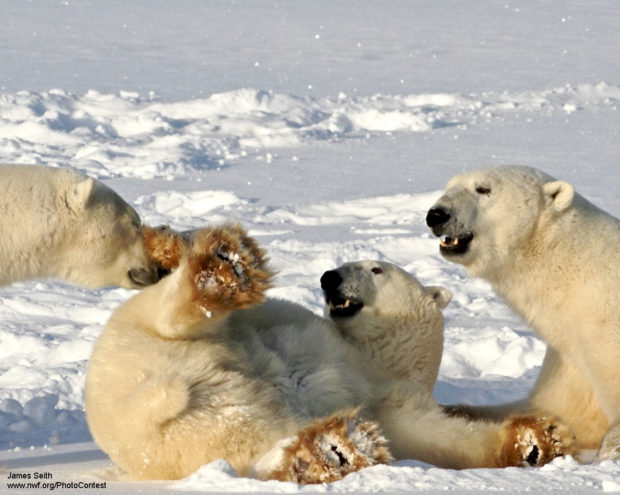We have much more to do and your continued support is needed now more than ever.
Watch 1,000 Polar Bears Spar and Nap as They Wait for Hudson Bay to Freeze (Live Cam)
An estimated 1,000 polar bears gather annually near the Churchill, Canada and wait for Hudson Bay to freeze over so they can hunt seals and other marine mammals. This live stream reveals what polar bears do as they wait for the water to freeze. This video is courtesy of explore.org, Polar Bears International, and Frontiers North Adventures.
Frequently Asked Questions
We’ve compiled answers to some of the most common questions related to the polar bear cam. Feel free to ask additional questions in the comments and we’ll do our best to answer them.

Why Do Polar Bears Spar?
You may observe polar bears on their hind legs, pushing each other around. This is known as “sparring” and is commonly mistaken for fighting. It’s actually play fighting, which plays a part in establishing the strongest bears, practicing for hunting and developing a hierarchy.
What Do Polar Bears Eat?
Polar bears are carnivorous (almost exclusively meat eaters). They mainly eat ringed seals, and will also eat other species of seals, walruses, and whale carcasses. Hungry polar bears will search out bird eggs and other food sources, but none of these are plentiful enough to sustain the large body mass and dense populations of polar bears.
How Do Polar Bears Hunt Seals?
Polar bears wait for seals to come to the surface of sea ice to breathe. When the seal nears the surface, the polar bear will bite or grab the seal and pull it onto land to feed.
Another vitally important food source in most areas are seal pups that are born and live in dens in the arctic ice. The polar bear identifies these dens by smell and other markers and pounces though the roof of the den to capture the young seals. In Hudson Bay, the availability of seal pups in the spring is increasingly limited by earlier melting of ice. In the Arctic, polar bears are at the top of the food chain; they eat everything and nothing (but native hunters) eats them.
Why Do They Sleep So Much?
As the polar bears wait for Hudson Bay to freeze over, they rest to conserve energy for hunting. You may see them sleeping or taking a nap in the low shrubs of the tundra. Interestingly, they sleep for about 7 hours at a time, and nap in between.
How Have Polar Bears Adapted to Living in the Cold?
Many of the polar bear’s physical characteristics help maintain body heat and deal with their icy habitat:
- The outer layer of fur is hollow and reflects light, giving the fur a white color. The white fur helps the bear remain camouflaged in icy and snowy habitat.
- The footpads of a polar bears’ paws have a kind of “non-slip” surface allowing them to get traction on slippery ice.
- Polar bears have a thick layer of fat below the surface of the skin, which acts as insulation on the body to trap heat. This is especially important while swimming and during the frigid arctic winter.
- Large body size reduces the amount of surface area exposed to the cold per unit of body mass (pounds of flesh) which generate heat.
- Polar bear dens can be 38 degrees F warmer than the outside temperature.
Here’s a few more things you may not know about polar bears! And did you know that you can help protect polar bears by symbolically adopting one?





















